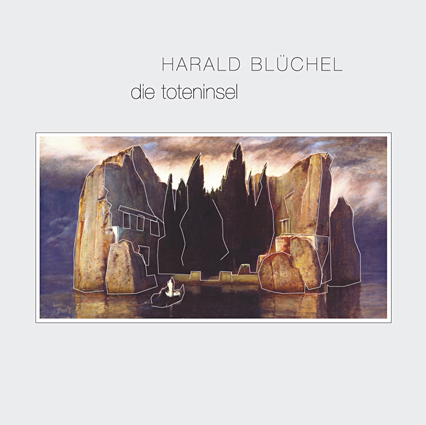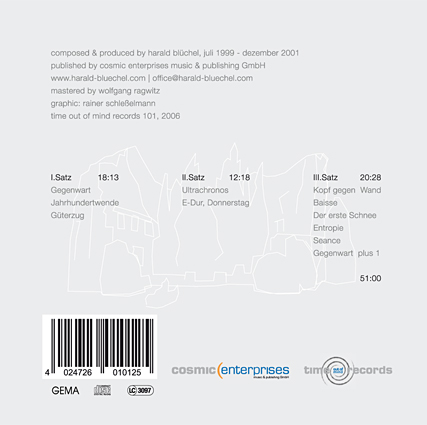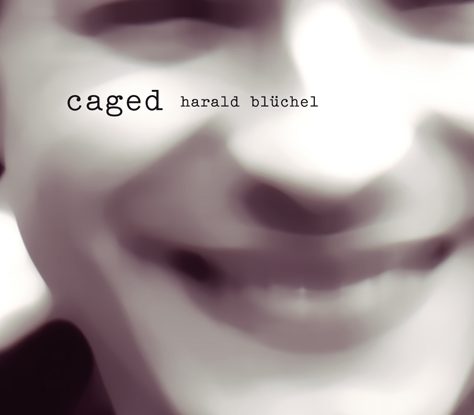

produced between July 1999 & Dec. 2001 | released on time out of mind records, Sept. 2006 | format: CD
1 Ist Movement 18:13
The present – the turn of the century –
Freight train
2 II.Satz 12:18
Ultrachronos – E-major, Thursday
3 III.Satz 20:28
Head versus wall – Baisse – The first snow –
Entropy – Seance – The present plus 1
composed & produced by harald blüchel, 1999-2001
published by cosmic enterprises music & publishing GmbH
mastered by wolfgang ragwitz
graphics: rainer schleßelmann
TOOM 101, August 2006
NOTES:
Transformation (1999 – 2005)
1
Basically I had 20 years to set up the “Stellar”/“Cosmic Baby” plateau (from the age of 5 to 25) – until all it needed was a spark to set off the creative chain reaction. That spark was the euphoria of a certain time, the motor with which I emotionally idealized my desires to the world and charted out my place in it:
in a Joseph Beuyss’ sense, convey WARMTH, Beethoven’s “All men become brothers” – wanting to make dreams tangible and bring them to life – in a suitable musical form ( “Galanter Stil” ), but new.
Later: at first just a vague idea, then certainty, to have things at an elevated level… also the astonishment how much this realization helped as a filter on reality (putting the beautiful stuff on a pedestal, repressing the doubts) to promote creativity.
Dis – illusionment.
Thereafter: the question of which conclusions should have been drawn. The maneuvering, the disappointment, either towards resolving anger / arrogance / bitterness / cynicism or, even better, to come to more constructive conclusions. What remained was a conscious departure from an idealized, heavily filtered means of interpretation, experience, living. I decided to bridge the gap between the art world and real life to put my feet on more solid ground, i.e. to become less prone to bribes and persuasion by being more independent from the legal mind-bending drugs such as stardom, status, money, consumerism, sex.
So: my return to “chamber music”, away from the situations of euphoric mass meetings towards still moments (not chill moments!), towards intimacy, the question of identity (in contrast to posing/staging). Quieter, less puffed up, and more different, more differentiated, more skeptical, more multi-dimensional, thus, more polarizing: no longer “wanting to please” at all costs…myself, the public, the market.
Breaking down the grand gesture into its more complicated components. If possible, without losing the “light in my eyes” (which happened more often than I wanted).
The big wish, to come at some time to that point where the composition of the separate components represent a more complex whole, not too cerebral, but certainly without any simplification / stylization / tailoring (and thus down-grading) of the result.
2
“Art is beautiful but demands a lot of work.” I have always found it rather strange when a DJ or “artist” prattled about “having quickly made a track” yesterday (himself or the audio control engineer in the background?) and when the Zeitgeist rejoiced in such musical naiveté as being an “achievement” (until the same Zeitgeist throws out the baby with the bath water due to excessive uniformity and randomness and abundance of such works whose substance soon dissolves.) Music increasingly becomes less trying, more arbitrary, more interchangeable both with regard to production and consumption due to such dilettantes within the music, media and consciousness industries who are merely driven by the market and the wish to be popular and successful. The result of all this is a mass of uniformity which bores and constantly cries out for something “new”, some new material that is easily and quickly promoted and digested. Then everybody chases after the “next big thing” with a durability of under 3 months. Promotion will do the trick … Yet subtlety and expression, individual creativity and inventiveness have to do with “capability” that one gains by working hard. That sounds “out-dated” to the sapidity agents but due to a lack of opportunities they have no other choice than to act according to this. For this is the only thing they have learned in the wonderful here and now of fun maximisation in which there is always profit maximisation: “acting” in the capitalist, not in the philosophical sense of the word.
3
On the „Zauberberg-Trilogie“
By compressing content and style to the degree it does, “pop music” generally has to remain one dimensional. It is based on the principle of repeating (sometimes conditioned) listening habits. The years 1999 to 2003 were marked by a desire to make music that could transport multilayered structures; music which did not per se attempt to catch the ears of its listeners as effortlessly as a soundbite; I wanted to explore new ground and began to create what I call “Hörstücke” (listening pieces).
The first step was to search for and try out new ways to compose and create sound. During this process I covered the whole range from the Synth / MIDI-technique (which I still used in some sections of Part I of “Toteninsel”) to electro-accoustic sound research. Examining, processing and changing natural sounds enabled me to arrange new soundscapes that had been previously unheard. Firstly, this aroused my interest in examining sounds of any kind on equal terms without imposing any hierarchy among them. Secondly, it triggered a new approach to classical music instruments.
The “Zauberberg–Trilogie” is my attempt to document this transitional period in my work.
“Zauberberg” is the image for a place separate from everyday life and from its functional patterns and functional laws, both in space and in spirit. A place which – due to its separateness – can enable “distanced” positions, insights and attitudes. For a long time now I have been interested in a contradiction I have experienced repeatedly – the conflict between what we “think” we are and what we really are, i.e. our own inner reality (the determinant of our actions on a subconscious level).
I wanted to find musical forms to transform into sound the questions that make up the discussion of existential questions: “What is a human being?”, “What does a human being feel?”, “What does a human being experience?”, “Why do human beings feel and act the way they do?”.
My inspirational core is Romanticism’s philosophical tradition (particularly Hölderlin – Robert Schumann – Caspar-David Friedrich) temporally flanked, questioned and suspended by Heinrich von Kleist, Karl Marx and Sigmund Freud.
Part I tells of the beginnings of the search for a future language of sound, which might be defined by the term “Hörstück” (“listening piece”). It is still quite heterogenous in “Toteninsel”: the musical material is based on a kind of stock-taking of various sound, composition, and production techniques that are brought together like pieces of a collage to create a soundscape.
The compositions, the recordings and their dramaturgical structure and realization in three musical movements arose in the period from July 1999 to December 2001. In May and June 2005, they were listened to again critically with a few changes being made to the order and the mix of individual parts. No structural changes, new recordings or aural reworking was performed as I wanted to retain the authenticity of the original material, documenting the time at all cost
Intellectual aspects
I
In 1880 the artist Arnold Böcklin (1827-1901) was commissioned by a young widow to paint “a picture to dream by”. In the same year Böcklin wrote his client a letter stating that “the picture has to be so captivatingly still that you would get a fright if someone knocked at the door.” The first version of this painting was titled “Stille” (silence/ peace and quiet) accordingly. The four following versions were titled “Die Toteninsel” (The island of death).
II
To go for a row over a totally calm lake into another world, is so fascinatingly beautiful as it is threatening and unknown.
III
My feelings on viewing the painting go massively beyond what I see. “Die Toteninsel” incites my fantasy. The associated creative impulse finds its expression in a musical piece that no doubt can be seen as a fragment in the classical, romantic sense. Its basic motive is reflection on the relation between “time and thoughts”.
IV
On thinking: “In our thoughts, all the possibilities of one’s personal design lie beside each other ranked equally. In our thoughts, it is not possible to distinguish between what has become real and what is still a dream” (Helmut Krausser, “UC”). Anything that has been considered, desired, or avoided actually loses its distinctive identity in the world of our thoughts. The same is true for the differences between one’s own experiences, realizations, and life-story and those that are “second-hand” (films, books, interpretations) so that the borders between “happened” and “desired” or “my own” and “outside me” break down, as does the division of time into “past-present-future”.
V
On time: it can be assumed that a mayfly lives its life just as intensively and perceives it to be just as long as we see our own lives. A snail has its own criteria for slow and fast, just like any other living creature in its environment. On the basis of these simple examples, there are no objective criteria for time. Time is relative – therefore it is a subjective quantity.
When slowed down using technology, a tone that we perceive as a high frequency, that of a song-bird for example, is suddenly revealed as a highly complex melodic sequence running over several measures. And if a table tennis player had the ability to slow his perception of a rally into slow motion, he would have much more time to get ready for the next stroke. Perceived time would expand.
VI
My fragment for the “Toteninsel” attempts to approach these ideas. Lets assume, someone is smoking a cigarette. While drawing in, thoughts go through her head, layered and in parallel. At best she will only be aware of just the tip of these associations, be able to infer a motive, extract a leading voice out of the full score of her real-time flow of thought. If she had the possibility to slow down time, she could dive deeper into what we call the “sub-conscious”; could experience more about her own world and would be forced to make a different association of herself to her external world – however this looks and whatever consequences this would have for her ability to synchronize. She would start out on an interesting journey: in a boat on a totally calm lake to an unfamiliar island. Let’s try to expand time for a moment, from three seconds to approximately fifty minutes…
textual material
gegenwart
wir sehen sie vor uns
diese männer
unrasiert, ungewaschen,
das gesicht schwarz unter dem stahlhelm,
das gewehr fest an sich gewandt,
die handgranate im stiefelschaft steckend,
fünf gestalten springen über eine kreuzung und
erreichen die nächste strassenzeile.
der kampf geht weiter
die waggontüren waren von aussen verschlossen
man hatte die riegelung geöffnet.
sofort wie wir ausgestiegen sind
ist vor unseren augen ein
fürchterliches bild.
an den geleisen vis-a-vis
stand ein verlassener zug
und vor dem zug, vor den waggonen
hunderte und tausende von reisegepäcken
aufeinander gestapelt.
gegenwart
und sagte denen also:
„kleidet euch aus, ihr werdet
geduscht und desinfiziert“.
an diesem gang
lagen dann verschiedene kammern,
ohne jede einrichtung,
kahl, nackt, zementfussboden.
auffällig und zunächst
unerklärlich war nur,
dass in der mitte ein vergitterter schacht stand,
der bis zur decke führte.
es hatte zunächst keine erklärung.
es sagte,
dass eine öffnung vom dach aus,
gas
und zwar in kristalliner form,
das zyklon b …
bis zu diesem moment
war also der häftling
völlig ahnungslos
und dann war es
natürlich zu spät
„die gehen baden,
in einer stunde werden sie sich wieder sehen“.
da schrie ich
nach meiner frau und
nach meinen kindern –
auf ungarisch nach und
bin wieder zu meiner gruppe
zurück gegangen.
nie habe ich sie mehr gesehen
gegenwart
stürzt ab
sinken
deutlich sinken
so tief wie noch nie
noch sehr viel schlimmer noch
dort ging es ebenfalls steil abwärts
siemens
infineon
die aktie gelb
dort stürzten die Papiere
telekom-aktien kamen noch schlechter weg
ein schnäppchen machen
der erste schnee
fun
success
freedom
power
safety
adventure
sex appeal
happyness
comfort
progress
gegenwart
REVIEWS:
HARALD BLÜCHEL − eine schillernde Persönlichkeit. Hier einige wesentliche Fakten: Geboren 1963 in Nürnberg, Hochbegabtenstipendium (das hat er mit mir gemein ;-), Hörspielproduktionen, Teilnehmer an der ersten Love Parade, 1991 das Auftauchen seines Alter Egos COSMIC BABY, Riesenerfolge unter diesem Künstlernamen (der „Messias des Techno“, 1999 letzter internationaler CB-Live Auftritt vor 10000 Besuchern in Tampa, Auslandsaufenthalte, 2004 VÖ einer Zusammenarbeit mit SCHILLERs van Deylen („Bi Polar“). Und das ist nur eine ganz kurze Rundreise durch die Vita des Deutschen, den ich bislang zugegebenermaßen nicht so im Fokus hatte. Warum jetzt also HARALD BLÜCHEL im Terrorverlag? Weil er mit seiner neuesten Produktion andere Wege geht, die ihn äußerst interessant für elektronische Avantgarde Hörer macht. Seine ursprüngliche Intention: Weg von den billigen in wenigen Stunden erstellen Tracks, hin zu persönlicheren/ intensiveren Klängen. „Zerlegung des grossen Gestus in seine komplizierteren Einzelteile. Der grosse Wunsch, irgendwann an den Punkt zu kommen, an dem die Zusammensetzung der Einzelteile ein komplexeres Ganzes darzustellen vermag.“ Dieses durchaus intellektuelle Zitat könnte ebenso von MARTIN STEINEBACH oder diversen Cold Meat Künstlern stammen, und so weit entfernt ist der klangliche Output dann auch nicht. „Die Toteninsel“stellt dabei den ersten Teil der sogenannten „Zauberberg-Trilogie“dar, über deren Hintergründe das auskunftsreiche Booklet detailliert informiert. Der Titel „Die Toteninsel“nimmt wiederum Bezug auf ein berühmtes Gemälde. Hierzu ebenfalls ein paar erhellende Sätze aus Sekundärquellen: „Der Schweizer Maler Arnold Böcklin (1827-1901) erhielt 1880 von einer jungen Witwe den Auftrag für „ein Bild zum Träumen“ Seiner Auftraggeberin schrieb Böcklin in einem Brief im gleichen Jahr, „das Bild müsse so still werden, das man erschrickt, wenn an die Tür gepocht wird“ Die erste Version des Bildes hieß dementsprechend „Stille“ die vier folgenden Versionen erhielten den Titel „Die Toteninsel“. Mithin also ein eher melancholisch depressives Thema, wie ist das ganze nun musikalisch illustriert worden? Zunächst als 51 minütiges Hörstück in abgegrenzten Unterparts. 1. Satz: Die „Gegenwart“vertraut auf Ambient-Klänge, wie man sie von entsprechenden Genrekünstlern kennt, während die „Jahrhundertwende“auf Streicher-artige weiträumige Melodiebögen und Flächen setzt. Der „Güterzug“− ganz seinem Namen verpflichtet − bietet uns den Lärm der industriellen Revolution in all ihren Facetten an, dazwischen ein paar Sprachfetzen. Homogen ist anders, aber man muss hier auch den experimentellen Charakter der 1999 bis 2001 entstandenen Kompositionen miteinbeziehen. Blüchel ist hier noch ein Suchender, der sich fasziniert von neuen Klangwelten an unterschiedlichsten Ausdrucksformen versucht. 2. Satz: SCHILLER-Fragmente bei „Ultrachronos“ ein Piano-Zwischenspiel bei „E-Dur, Donnerstag“ 3. Satz: „Kopf gegen die Wand“ Leichte Industrialanklänge illustrieren diesen nicht gesundheitsfördernden Vorgang. „Baisse− Sprache im Sinkflug mit Harfen-Erlösung. „Der erste Schnee“ Perlende Soundflocken im 80er Gewand (FALTERMEYER lässt grüßen). „Entropie“ sowie „Seance“ Typische SCHILLER-Sequenzen, die ersten „richtigen“Songs des Silberlings inklusive Percussion – sehr gefällig. Zum Abschluss die „Gegenwart plus 1“(also die Zukunft?!)… die düstere Klammer zum Beginn, die Stille erreicht den Raum und der Reisende die Toteninsel. Sicher ein ambitioniertes Werk, zu dem nicht alle Zugang haben werden, zu heterogen sind die elektronischen Landschaften ausgefallen. Wenn man aber die Prämisse der experimentellen Klangcollage in Verbindung mit dem Motiv des stillen Gemäldes akzeptiert, kann ein erstaunlich interessantes „Kopf“ino in Gang gesetzt werden, am besten ungestört unter dem „Kopf“örer. Für Freunde von Ambient bis hin zu sphärischem Noise eine spannende Entdeckung, alle anderen werden eher zu den just erschienenen Neuauflagen des COSMIC BABY-Back Katalogs greifen…
Karsten Thurau, Terrorverlag (26.09.2006)
Für Hedonisten, die Harald „Cosmic Baby“ Blüchel mit seinen legendären Tech-Trance- Produktionen oder seiner Zusammenarbeit mit Schillers Christopher von Deylen assoziieren, ist sein erster Solo-Release seit 1999 eine kalte Dusche − und das nicht wegen des nassen Elements auf dem Cover, eine Variation von Arnold Böcklins Gemälde „Die Toteninsel“ (1880 – 83). Mit dem in drei „Sätze“ gegliederten elektronischen Hörstück − eine vage dem Dark- Ambient-Genre zuzurechnende Komposition, deren philosophischen/kunsthistorischen Background Blüchel im Booklet erläutert − kehrt der nun auch schon 40-Jährige in gewisser Hinsicht zu seinen Anfängen als studierter Tonschöpfer und Klassik-fan zurück. Kein Beat hier, der Raver-Bedürfnisse bedient; es ffließt ein breiter Strom aus dunklen Klangflächen, spätromantischen Piano-Motiven und mysteriösen Vokal-samples. Uneasy-Listening-Freunde kommen auf ihre Kosten.
Albrecht Piltz, Keys 12/2006
So düster der Titel auch klingen mag, so angenehm ist die Hörerfahrung. Was sich auf „Stunde Null“ (1996) bereits andeutete, formuliert der vormals als Cosmic Baby bekannte und in letzter Zeit mit Christopher von Deylen (Schiller) kooperierende Musiker endlich zuende. Er nähert sich aus den fest gefügten Strukturen von Beat einem formal freien Konzept von Klang, einem „Hörstück“, wie er es nennt. In den drei durchschnittlich 17minütigen Movements erschafft er ein wortloses Hörspiel, welches sich zwischen „Ambient“ von Brian Eno, dem „Chill Out“ von KLF und dem „Waiting for Cousteau“ von Jean Michel Jarre bewegt, und dann einfach einen Schritt weiter geht. Musik für die Gegenwart ±1
Frank Hilpert, Freshguide 12/06
Ein Brocken. Noch dazu ein großer. Naheliegend, dass das nicht leichtverdaulich ist. Wer von Harald Blüchel nur seine Trancemeilensteine als Cosmic Baby oder Energy 52 kennt, wird überrascht sein ob der sehr minimalen Hörstückkompositionen auf dieser Trilogie. Es geht in Bezugnahme auf Thomas Manns berühmten Roman „Der Zauberberg“ um Entfremdung und den daraus neugewonnenen Blickwinkel auf eine Welt, in der man nicht mehr involviert ist. Blüchels erster Teil greift das Motiv der „Toteninsel“ auf, einer berühmten Gemäldeserie von Arnold Böcklin und versucht eine flächige Umsetzung in elektronische Musik. Bis zu zwanzigminütige soundtrackhafte Stücke entfalten schleichend ihre Wirkung. Der unheilschwangere erste Satz (Termini der klassischen Musik sind hier durchaus sinnvoll) enthält einige Zitate aus den Ausschwitzprozessen. Wie gesagt, nicht gerade Easy Listening. Zweiter und dritter Satz sind wesentlich freundlicher, aber immer noch entrückte Musik, die Deinen Kopf fordert.
Hauke Schlichting, Raveline 2/07


